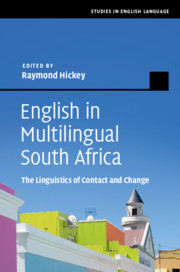Book contents
- English in Multilingual South Africa
- Studies in English Language
- English in Multilingual South Africa
- Copyright page
- Contents
- Figures
- Maps
- Tables
- Contributors
- Preface
- I A Framework for English in South Africa
- Chapter 1 English in South Africa: Contact and Change
- Chapter 2 South Africa in the Linguistic Modeling of World Englishes
- Chapter 3 South African English, the Dynamic Model and the Challenge of Afrikaans Influence
- Chapter 4 The Historical Development of South African English: Semantic Features
- Chapter 5 Regionality in South African English
- Chapter 6 Does Editing Matter? Editorial Work, Endonormativity and Convergence in Written Englishes in South Africa
- II Sociolinguistics, Globalisation and Multilingualism
- III Language Interfaces
- Timeline for South African History
- Glossary
- Index
- References
Chapter 6 - Does Editing Matter? Editorial Work, Endonormativity and Convergence in Written Englishes in South Africa
from I - A Framework for English in South Africa
Published online by Cambridge University Press: 07 November 2019
- English in Multilingual South Africa
- Studies in English Language
- English in Multilingual South Africa
- Copyright page
- Contents
- Figures
- Maps
- Tables
- Contributors
- Preface
- I A Framework for English in South Africa
- Chapter 1 English in South Africa: Contact and Change
- Chapter 2 South Africa in the Linguistic Modeling of World Englishes
- Chapter 3 South African English, the Dynamic Model and the Challenge of Afrikaans Influence
- Chapter 4 The Historical Development of South African English: Semantic Features
- Chapter 5 Regionality in South African English
- Chapter 6 Does Editing Matter? Editorial Work, Endonormativity and Convergence in Written Englishes in South Africa
- II Sociolinguistics, Globalisation and Multilingualism
- III Language Interfaces
- Timeline for South African History
- Glossary
- Index
- References
Summary
This chapter focuses on the relationship between editorial work, endonormativity and convergence in the South African context, presenting a corpus-based quantitative case study of how editing reshapes academic writing by users of the STL (White South African English, or WSAfE) and IDG (Black South African English, or BSAfE) strands in South Africa. An inductive, exploratory quantitative method is used to identify linguistic features that distinguish unedited BSAfE and WSAfE academic writing, and edited BSAfE and WSAfE academic writing, using a corpus of edited texts and their unedited counterparts. Two features are analysed in detail: the use of downtoners and possibility modals. The findings provide support for the endonormativity of BSAfE, with WSAfE more ambiguous. The two strands are largely divergent in their usage of the two individual features. With a few exceptions, editors leave BSAfE usage patterns unaltered but sometimes change WSAfE usage to be closer to British English usage. Editing thus either leaves the stylistic distance between the two varieties unaltered or increases it. These findings support an assessment of (sometimes problematised) endonormativity at the level of the individual strands, but no strong evidence for convergence.
Keywords
- Type
- Chapter
- Information
- English in Multilingual South AfricaThe Linguistics of Contact and Change, pp. 101 - 126Publisher: Cambridge University PressPrint publication year: 2019
References
- 3
- Cited by

